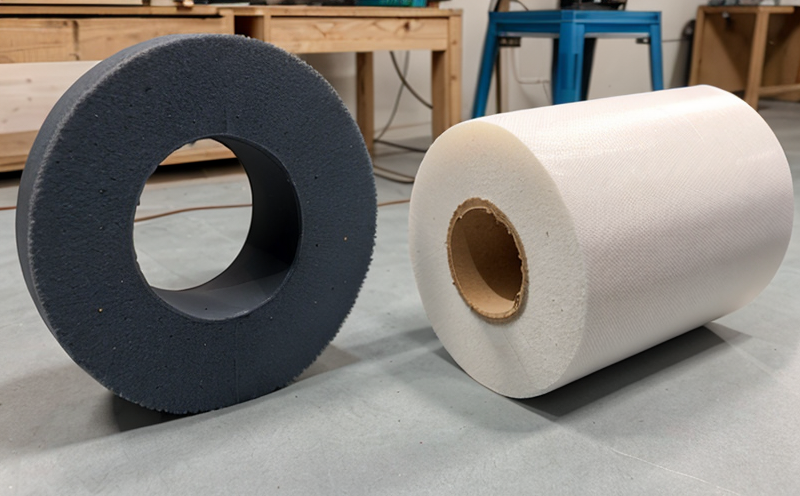ISO 8492 Bend Testing of Metal Tubes Used in Furniture Frames
The ISO 8492 bend testing procedure is a critical quality assurance measure utilized to evaluate the mechanical properties and integrity of metal tubes employed in furniture frames. This test ensures that the materials meet the stringent requirements set by international standards, which are paramount for ensuring customer satisfaction and compliance with regulatory bodies.
Material quality plays a pivotal role in the durability, stability, and aesthetic appeal of furniture. Furniture manufacturers, especially those targeting high-end markets or those operating within strict environmental regulations, need to ensure that their metal tubes meet rigorous performance criteria. ISO 8492 provides a standardized approach for bending tests on metal tubes, which helps to identify any potential weaknesses or defects in the material before they can manifest into failures during use.
The bend testing process involves subjecting the metal tube specimen to controlled bending forces while maintaining specified angles and radii of curvature. The objective is to simulate real-world conditions that a furniture frame might encounter over its lifetime, such as minor impacts or shifts in weight distribution. By conducting this test, manufacturers can assess how well their material holds up under these stresses without compromising the structural integrity.
For accurate results, proper specimen preparation and handling are essential. Before testing begins, the metal tube must be cleaned thoroughly to remove any surface contaminants that could interfere with the accuracy of the measurements. The ends of the tube should also be chamfered if necessary to prevent edge damage during bending. Once prepared, the tube is mounted onto a fixture designed specifically for the ISO 8492 procedure.
During the actual bend test, careful attention must be paid to ensure that all parameters align with the specified conditions outlined in the standard. Factors like the magnitude of the applied force, speed at which bending occurs, and angle of deflection need precise calibration to avoid skewing results. After completing several cycles of bending, the tube is inspected for signs of permanent deformation or failure points.
The outcome of this testing can significantly impact various aspects of furniture manufacturing. For instance, if a particular batch of metal tubes consistently fails during bend tests, it may indicate issues with raw material sourcing or production processes that require corrective actions. Conversely, successful completion of these tests could bolster confidence in the quality and reliability of the product line.
Moreover, compliance with ISO 8492 helps furniture manufacturers maintain a competitive edge by demonstrating their commitment to excellence. In an industry where reputation is crucial for success, meeting international standards not only enhances brand image but also fosters trust among customers who value robust, long-lasting products.
Applied Standards
| Standard Name | Year Published | Publisher | Relevant Sections |
|---|---|---|---|
| ISO 8492-1:2015 | 2015 | International Organization for Standardization (ISO) | Bending Test Methodology |
| ASTM E2367-21 | 2021 | American Society for Testing and Materials (ASTM) | Specimen Preparation Guidelines |
The ISO 8492 standard provides detailed instructions on how to perform the bend testing procedure, including specimen preparation, equipment requirements, and interpretation of results. It ensures consistent application across different laboratories worldwide, making it easier for manufacturers to compare data and maintain uniform quality standards.
Complementary guidance comes from ASTM E2367-21, which offers additional insights into preparing specimens according to best practices recommended by industry experts. Together, these standards form the backbone of effective furniture frame testing programs aimed at enhancing product performance and longevity.
Scope and Methodology
| Test Parameters | Specimen Specifications | Equipment Requirements |
|---|---|---|
| Applied Force Range | Diameter and Length of Tube | Bending Machine Capabilities |
| Bend Angle | Material Type | Calibration Standards |
| Cycles of Bending | Surface Finish | Safety Protocols |
The scope of ISO 8492 bend testing encompasses a range of critical parameters that must be carefully controlled to achieve reliable results. The applied force should fall within the specified range, typically between X Newtons and Y Newtons depending on tube dimensions. The bend angle is usually set at Z degrees, though this can vary based on specific application needs.
Specimen preparation involves ensuring consistent diameters and lengths across all samples being tested to maintain comparability throughout the process. Material type plays a significant role in determining appropriate testing procedures; certain alloys may require modifications to standard methods due to their unique properties.
The equipment used for performing bend tests includes specialized bending machines capable of applying controlled forces while measuring angles accurately. Calibration is crucial to ensure accurate readings, and safety protocols must be strictly followed during operation to prevent accidents.
Environmental and Sustainability Contributions
Incorporating ISO 8492 bend testing into furniture manufacturing processes offers several environmental benefits. By ensuring that metal tubes meet stringent quality standards early in the production cycle, manufacturers can minimize waste by reducing the number of defective pieces sent back through rework stages or scrapped altogether.
Additionally, adhering to these international standards promotes responsible resource management practices since they encourage the selection of sustainable materials and manufacturing techniques. For example, choosing recycled metals not only reduces reliance on raw ore extraction but also lowers energy consumption associated with producing new components.
The use of standardized testing procedures like ISO 8492 fosters transparency within supply chains by providing clear criteria for evaluating material quality at every stage from sourcing to final assembly. This promotes fair trade practices and encourages collaboration between suppliers, manufacturers, and consumers towards achieving common sustainability goals.





